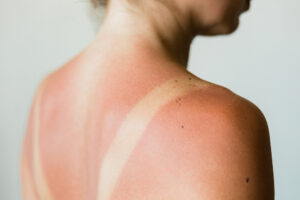Sunburn and hay fever are common summer health issues, but there are some you may not have heard about. GP Dr. Deyo Famuboni shares some summer health problems to watch out for and how to avoid them
Summer days mean spending more time outdoors. Though enjoyable, it can be unsafe, here’s what to watch out for..
#1 Eye injuries
We often take our eyes for granted, and whilst we might remember to use sunscreen, we often forget to protect our eyes.
Sunrays can lead to several eye problems, even on a cloudy day. From treatable conditions like inflammation of the cornea (photokeratitis) or an overgrowth of the conjunctiva (pterygium), to long-term damage with cataracts and macular degeneration, these eye conditions are associated with exposure of the eyes to sunlight.
Sunglasses will block UV – if you choose carefully
Symptoms include pain, noticing a growth in the eye and a decrease in your vision, respectively. In order to prevent these, it is important to protect the eyes using sunglasses that filter out UV rays. Sunglasses will block UV – if you choose carefully.
Light is measured in nanometeres, with UV rays measuring 320 to 390 nanometres. If sunglasses carry a CE mark (a European standard of UV protection) that means they should allow no more than 5 per cent of UV rays below 380 nanometres to get through.
The other thing you may see on your glasses is a UV 400 sign – which just means that the glasses should not allow in UV rays below 400 nanometers. Wearing a wide-brimmed hat also helps.
READ MORE: 12 surprising facts about sun and skin
#2 Food poisoning
Summertime means barbecues and salads. Although they can be healthy, the risk of food poisoning also increases if proper food handling rules are not followed.
Symptoms usually start between one to three days after exposure, and often range from mild, with bouts of diarrhoea or vomiting, to severe, with associated fevers, dizziness, decrease in urine frequency, dehydration, persisting abdominal pain, and blood and mucous in the stool.
Cleanliness, Cook thoroughly, Chill appropriately and avoid Cross-contamination
Mild food poisoning tends to be self-limiting, and staying hydrated with roughly 200mls (a small glass) of fluids for every episode is all that it takes.
If you have associated symptoms or concerns, it is best to seek medical advice. According to the Food Standards Agency, adhering to the ‘4 Cs’ helps prevent food poisoning: Cleanliness, Cook thoroughly, Chill appropriately and avoid Cross-contamination.
#3 Swimmer’s ear
Also known as otitis externa, swimmer’s ear is inflammation of the skin in the ear canal. Frequent swimming is a risk factor because water gets into the ear, which then irritates and inflames the skin.
This provides the right environment for micro-organisms to grow and cause an infection. The ear may become itchy or uncomfortable and they may discharge. Hearing may also become dull. Topical ear drops from the pharmacy often settle this.
The best way to prevent swimmer’s ear is to keep the ears dry, using a tight fitting cap when swimming, or silicone based earplugs, if they do not irritate the ear canals. Avoid irritating the ears by using cotton buds, fingers or towels.
READ MORE: 12 Spring & Summer dangers dog owners need to be aware of
#4 Hay fever
Becoming increasingly common, hay fever affects approximately one in four people in the UK. A person is more at risk if they have other allergies, such as asthma or eczema.
Hay fever is due to a reaction to the pollen from plants, resulting in inflammation and the typical symptoms of itchy and watery throat, nose and eyes; sneezing; coughing; headaches and tiredness. Some people are affected earlier in the spring, and others in late summer because of the different pollens released.
Some people are affected earlier in the spring, and others in late summer because of the different pollens released.
Decreasing pollen exposure can help to prevent symptoms. This includes avoiding outdoors during peak pollen count times, protecting eyes when outdoors, using protective balms around nostrils, showering and changing once indoors, and keeping doors and windows shut.
Treatments that help include antihistamines and nasal sprays that can be obtained over the counter. To prevent symptoms, it is often worth taking medications a couple of weeks before the season starts.
If symptoms are severe or you have other allergies, especially asthma, seeing your doctor would be beneficial as other treatments such as immunotherapy may help.
READ MORE: 7 sun-damaged skin fixes every beach lover needs to know
#5 Sunburn
This can happen with just a few hours of sun exposure, including sunbeds and sunlamps.
Hot skin that feels painful to touch is usually the first sign of sunburn. Blisters can also occur, and over a few days the skin can start to peel.
At the extreme end, you can get fevers, chills, headaches, fatigue, nausea or a rash. In the long-term, sunburn can cause chronic skin damage with wrinkles, sunspots and skin cancer.
Sun protection, even on a cloudy day, is the best way to prevent this. We all need vitamin D and though dietary sources exist, the sun is an important source.
Anti-inflammatory medications such as ibuprofen can help with the pain
Various opinions exist among dermatologists and scientists on sun exposure risk and obtaining vitamin D. The incidence of skin cancer is increasing, so sun protection is vital.
Also, even with sunscreens, some rays still reach the skin and this, combined with dietary vitamin D, may be adequate. If you do get sunburned, keeping hydrated and cooling the skin down with showers, cool compresses and topical gels such as aloe vera and moisturisers can help.
Anti-inflammatory medications such as ibuprofen can help with the pain. Seek medical attention if it doesn’t improve in a couple of days or there are associated fevers, headaches, dizziness, nausea, confusion, signs of an infection or blisters affecting a large part of the body.
READ MORE: How to detox your body this summer – an expert guide
#6 Lyme disease
As the warm weather sets in, we spend more time in the countryside. There are numerous health benefits to this, but insect bites, in particular from ticks, can be a cause for concern.
Lyme disease, or tick bite fever, can occur and cause both short- and long-term effects. Most people do not recall being bitten, but notice a bite with a red circular rash around it. This can happen between three days to about one month after the bit occurs.
long-term, chronic Lyme disease can manifest itself as mental or cognitive problems and arthritis
There can be associated flu-like symptoms. Some people can clear this without treatment; however, it can progress to cause joint pain, weakness, fatigue, heart and neurological problems if it’s not treated with antibiotics. In the long-term, chronic Lyme disease can manifest itself as mental or cognitive problems and arthritis.
Treatment is therefore important, should you be bitten by a tick. Prevention by being aware of areas with infestation, using insect repellent, wearing long sleeves, tucking your trousers in your socks and closed shoes is key.
Checking the skin daily for tick bites and removing ticks as soon as possible also helps. If found, use tweezers, forceps or a tick removal device to grasp the head and mouth parts as close to the skin as you can, and slowly pull upwards, away from the skin without crushing the tick.
READ MORE: 6 ways to hydrate on the move during a heatwave
#7 Heat exhaustion
When we sweat excessively, we lose salt and water and can easily become dehydrated in the summer. Body temperature also rises, which can lead to heat exhaustion. Associated nausea, headaches, faintness and dizziness can occur.
Moving to a cool place and drinking loads of fluids usually leads to recovery within 30 minutes. If left untreated, this can lead to heatstroke – when the body temperature rises above 40 degrees Centigrade.
Confusion, vomiting, fast breathing and loss of consciousness can occur. Heatstroke is a medical emergency and you should summon immediate medical help.
#8 Skin rashes
From prickly heat rash due to clogged sweat glands to allergic skin reactions from insect bites or exposure to plant sap or oak processionary moths, different skin rashes can occur in the summer.
Keeping the skin cool and exfoliating regularly to minimise build up of dead skin cells can help to prevent miliaria (prickly heat rash). Allergic skin rashes tend to be self-limiting and oral antihistamines and topical creams can help with the symptoms of itch and inflammation.
different skin rashes can occur in the summer
The rash from oak processionary moths (these can occur up to around 20 metres from affected oak trees) in particular can last a few weeks. There may be associated sore throat, eye and breathing problems- a condition called lepidopterism.
Should this occur, it is advisable to seek medical help. If you have a history of severe allergic reactions, always remember to have your adrenaline pen with you.
HEALTHISTA’S ANSWER TO MENOPAUSE: PRESS PLAY, NOT PAUSE.
The Healthista Menopause Pack is a fully comprehensive online video workshop, led by Dr Dawn Harper; affordable, accessible and covering all aspects of the menopause, for those who need it most.
With expert advice and information from seven credible menopause industry experts, we hope that this online resource will help women navigate common health and wellness changes and challenges they may experience before, after and during the menopause.
Like this article? Sign up to our newsletter to get more articles like this delivered straight to your inbox.



























































